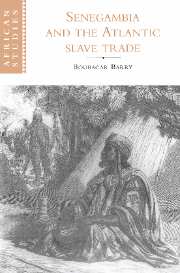Book contents
- Frontmatter
- Contents
- Preface
- Map
- I Senegambia from the fifteenth to the seventeenth century: a haven for incoming populations, a station for migrants on the move
- II Senegambia in the eighteenth century: the slave trade, ceddo regimes and Muslim revolutions
- 5 The slave trade in the eighteenth century
- 6 The strengthening of ceddo regimes in the eighteenth century
- 7 Muslim revolutions in the eighteenth century
- 8 The impact of the slave trade: economic regression and social strife
- III Senegambia in the first half of the nineteenth century: legitimate trade and sovereignty disputes
- IV Senegambia in the second half of the nineteenth century: colonial conquest and resistance movements
- Conclusion
- Notes
- Bibliography
- Index
- Other books in the series
5 - The slave trade in the eighteenth century
Published online by Cambridge University Press: 31 October 2009
- Frontmatter
- Contents
- Preface
- Map
- I Senegambia from the fifteenth to the seventeenth century: a haven for incoming populations, a station for migrants on the move
- II Senegambia in the eighteenth century: the slave trade, ceddo regimes and Muslim revolutions
- 5 The slave trade in the eighteenth century
- 6 The strengthening of ceddo regimes in the eighteenth century
- 7 Muslim revolutions in the eighteenth century
- 8 The impact of the slave trade: economic regression and social strife
- III Senegambia in the first half of the nineteenth century: legitimate trade and sovereignty disputes
- IV Senegambia in the second half of the nineteenth century: colonial conquest and resistance movements
- Conclusion
- Notes
- Bibliography
- Index
- Other books in the series
Summary
The slave trade had a tremendous impact on Senegambian societies. To understand their development, therefore, we need to examine more closely this complex process during which, as Jean Copans has pointed out, primary producers themselves, as potential slaves, became the main product. Whatever else might be said about it, the slave trade, with its logical corollary of slave raids, became between the second half of the seventeenth century and the first half of the eighteenth the main business of the British, French, Portuguese, and Dutch settled on the Senegambian coast and elsewhere.
Slave trading was a key element in the colonial mercantile system. Furthermore, it was a sort of imperative in international competition. For at the time, all conflicts over control of the sugar trade were primarily about possession of captive African labor and trading outlets. To satisfy its “hunger for Negroes,” Europe imposed the slave trade as a permanent reality, with the complicity of the region's reigning aristocracies. In this way Europe created conditions for the economic, political, and cultural takeover of Africa in the second half of the nineteenth century. Senegambia may have been a supplier of secondary importance. But this region too suffered from the slave trade, and its progress continues to be hampered by the longterm effects of the slaving era. So attempts by historians like Philip D. Curtin to minimize the number of slaves exported and the impact of slave raids on Africa's evolution run a high risk of becoming exercises in absurdity.
- Type
- Chapter
- Information
- Senegambia and the Atlantic Slave Trade , pp. 61 - 80Publisher: Cambridge University PressPrint publication year: 1997

